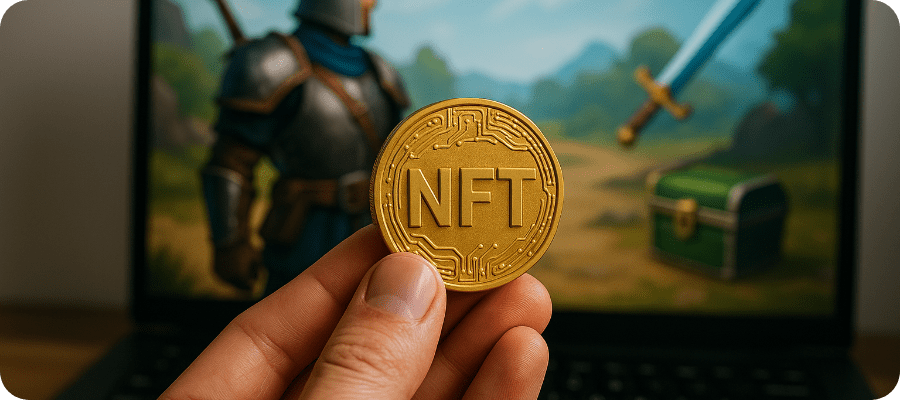[ez-toc]
The integration of non-fungible tokens (NFTs) into gaming ecosystems has introduced a paradigm shift in how players interact with digital assets. By using blockchain technology, NFTs enable verifiable ownership, interoperability, and monetization of in-game items—capabilities that challenge traditional centralized models.
Current Applications and Real-World Impact
NFTs are already transforming gaming economies. In 2024, the global gaming NFT market reached $4.8 billion, driven by play-to-earn (P2E) models like Axie Infinity, where players earn tradable NFTs through gameplay. Projects such as Decentraland and The Sandbox have built virtual real estate markets, with land parcels selling for over $2.5 million in 2024. These platforms allow users to retain ownership of assets even if they stop playing, a stark contrast to conventional games where items remain locked within proprietary ecosystems.
Blockchain networks like Ethereum and Polygon underpin most NFT gaming platforms, ensuring transparency and reducing fraud. For instance, Illuvium, a blockchain RPG, lets players trade NFT-based characters and items across multiple games, creating a unified digital economy. Similarly, Sorare, a fantasy soccer game, reported $150 million in NFT card sales in 2024, demonstrating the viability of NFT- driven sports simulations.
Similarly, in gaming areas such as iGaming, which have different social casinos available on platforms offering the best online casinos, crypto currencies are becoming a regular means of transactions.
Technological and Economic Shifts
NFTs address long-standing issues in gaming, such as the lack of true asset ownership. In 2025, 68% of blockchain games now allow cross-platform NFT transfers, enabling players to use items like skins or weapons in unrelated games. This interoperability is powered by standards like ERC-1155, which streamline asset portability. Additionally, Layer-2 solutions (e.g., Polygon) have reduced transaction fees by 92% compared to 2021, making microtransactions feasible.
The rise of fractional ownership models has further expanded accessibility. Platforms like RealT tokenize high-value assets, allowing gamers to co-own rare NFTs. For example, a $1.2 million virtual racecar in F1 Delta Time was divided into 10,000 fractional NFTs in 2024, each priced at $120.
Industry Adoption and Challenges
Major studios are cautiously embracing NFTs. Ubisoft’s Quartz platform, launched in 2023, lets players earn NFT gear in Ghost Recon Breakpoint, though backlash over environmental concerns prompted a shift to carbon-neutral blockchains. Meanwhile, indie developers dominate innovation: Star Atlas, a space exploration game, raised $50 million in 2024 through NFT ship sales.
Regulatory scrutiny remains a hurdle. The EU’s 2024 Markets in Crypto-Assets (MiCA) framework imposes strict KYC requirements on NFT marketplaces, complicating cross-border trades. Environmental criticisms persist, despite 74% of NFT games now using proof-of-stake blockchains, reducing energy consumption by 99% compared to proof-of-work systems.
Future Trajectories and Cross-Industry Synergies
By 2026, analysts project that 40% of AAA games will integrate NFTs, focusing on cosmetic items rather than pay-to-win mechanics. Emerging trends include AI- generated NFTs that adapt to player behavior, as seen in Alethea AI’s interactive characters.
Virtual worlds are becoming investment hubs. In 2025, The Sandbox partnered with Snoop Dogg to launch NFT-based concert venues, where ticket sales and merch royalties are automated via smart contracts. Such innovations hint at a future where in-game assets serve as collateral for decentralized loans or function across metaverse platforms.
Balancing Innovation and Sustainability
While NFTs unlock new economic models, their success hinges on solving scalability and inclusivity gaps. Projects like Immutable X aim to onboard 100 million gamers by 2030 through gas-free NFT minting. However, volatility risks persist: the average NFT game token lost 60% of its value during the 2024 crypto market correction.
As the industry matures, the focus will shift from speculative trading to utility-driven designs. NFTs’ ability to authenticate ownership and enable player-driven economies suggests they will remain a cornerstone of gaming’s Web3 evolution—provided developers prioritize user experience over short-term monetization.
